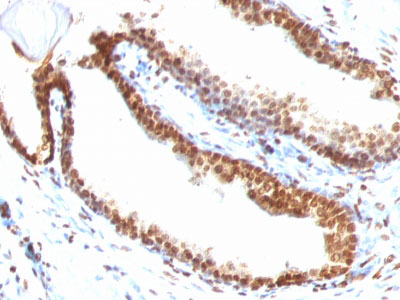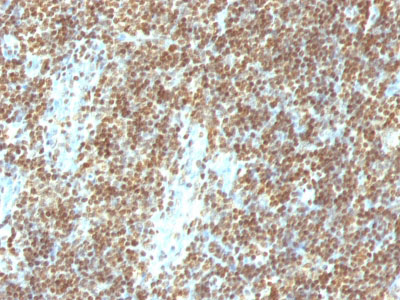Double Stranded DNA (dsDNA) (Nuclear Marker) Antibody - With BSA and Azide
Mouse Monoclonal Antibody [Clone DSD/958 ]
- 产品详情
- 实验流程
- 背景知识
Application
| IF, FC, ICC |
|---|---|
| Reactivity | Human |
| Host | Mouse |
| Clonality | Monoclonal |
| Isotype | Mouse / IgG3, kappa |
| Clone Names | DSD/958 |
| Calculated MW | Not Known |
| Application Note | IF~~1:50~200 FC~~1:10~50 ICC~~N/A |
|---|---|
| Storage | Store at 2 to 8°C.Antibody is stable for 24 months. |
| Precautions | Double Stranded DNA (dsDNA) (Nuclear Marker) Antibody - With BSA and Azide is for research use only and not for use in diagnostic or therapeutic procedures. |
For Research Use Only. Not For Use In Diagnostic Procedures.
Provided below are standard protocols that you may find useful for product applications.
BACKGROUND
This MAb recognizes the double stranded DNA in human cells. It can be used to stain the nuclei in cell or tissue preparations and can be used as a nuclear marker in human cells. This MAb produces a homogeneous staining pattern in the nucleus of normal and malignant cells. Deoxyribonucleic acid (DNA) is a nucleic acid that stores long-term information regarding the development and function of all known living organisms. DNA consists of two long nucleotide polymers, which are composed of four bases, namely adenine, thymine, guanine and cytosine, all of which are flanked by a phosphate-deoxyribose backbone. Normally, DNA exists as a double-stranded (ds) molecule that forms in the shape of a double helix, allowing the bases and the backbone of the two strands to interact, thus forming a polynucleotide. When the double helix is unwound (either by enzymes or heat), DNA exists as a single-stranded (ss) molecule that is less stable than the double helix, but is necessary for protein access to DNA bases. Double stranded DNA markers are useful tools in biology research and aid in the study of DNA behavior and characteristics.
REFERENCES
Epstein, A.L. and Clevenger, C.V., Identification of nuclear antigens in human cells by immunofluorescence, immunoelectron microscopy, and immuno-biochemical methods using monoclonal antibodies. In Progress on nonhistone protein research, Vol. 1, Isaac Bekhor, ed., 1985, CRC Press, Boca Raton, FL, pp 117-137
终于等到您。ABCEPTA(百远生物)抗体产品。
点击下方“我要评价 ”按钮提交您的反馈信息,您的反馈和评价是我们最宝贵的财富之一,
我们将在1-3个工作日内处理您的反馈信息。
如有疑问,联系:0512-88856768 tech-china@abcepta.com.























 癌症的基本特征包括细胞增殖、血管生成、迁移、凋亡逃避机制和细胞永生等。找到癌症发生过程中这些通路的关键标记物和对应的抗体用于检测至关重要。
癌症的基本特征包括细胞增殖、血管生成、迁移、凋亡逃避机制和细胞永生等。找到癌症发生过程中这些通路的关键标记物和对应的抗体用于检测至关重要。 为您推荐一个泛素化位点预测神器——泛素化分析工具,可以为您的蛋白的泛素化位点作出预测和评分。
为您推荐一个泛素化位点预测神器——泛素化分析工具,可以为您的蛋白的泛素化位点作出预测和评分。 细胞自噬受体图形绘图工具为你的蛋白的细胞受体结合位点作出预测和评分,识别结合到自噬通路中的蛋白是非常重要的,便于让我们理解自噬在正常生理、病理过程中的作用,如发育、细胞分化、神经退化性疾病、压力条件下、感染和癌症。
细胞自噬受体图形绘图工具为你的蛋白的细胞受体结合位点作出预测和评分,识别结合到自噬通路中的蛋白是非常重要的,便于让我们理解自噬在正常生理、病理过程中的作用,如发育、细胞分化、神经退化性疾病、压力条件下、感染和癌症。







